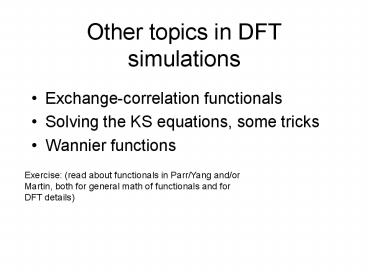Other topics in DFT simulations - PowerPoint PPT Presentation
1 / 11
Title:
Other topics in DFT simulations
Description:
Exercise: (read about functionals in Parr/Yang and/or ... The xc energies are for a uniform electron gas, and were obtained numerically by ... – PowerPoint PPT presentation
Number of Views:50
Avg rating:3.0/5.0
Title: Other topics in DFT simulations
1
Other topics in DFT simulations
- Exchange-correlation functionals
- Solving the KS equations, some tricks
- Wannier functions
Exercise (read about functionals in Parr/Yang
and/or Martin, both for general math of
functionals and for DFT details)
2
DFT functionals
- Martin p. 152
- LSDA
- The xc energies are for a uniform electron gas,
and were obtained numerically by QMC - We included spin up and down here which may apply
if spins are not paired
3
GGAs
- Include info from derivatives of the density.
Note uniform gas approximation is very extreme --
atoms are not at all uniform - One common form is BLYP, another is PBE, and
there are others
4
Hybrid functionals
- The most common one is B3LYP, developed by Becke,
which includes some degree of exact HF exchange. - This improves accuracies quite a lot, making DFT
about as good as MP2 - The drawback with the hybrids is that computation
of the exchange matrix is more expensive than the
near local GGAs
Exercise Martin references some studies which
compare these methods in tests on molecules. Look
some of those up. (p. 169 Martin)
5
Solving the KS equations
- Initial guess for wave functions --gt n(r)
- That n(r) creates a new Veff(r)
- Solve KS equations (expensive step). This --gt new
n(r) - Keep repeating until the process converges and
n(r) does not change
6
Total energy functionals
- KS total energy functional
- KS eigenvalues
- Kinetic energy
Exercise understand Martins argument about the
Importance of using in and out in the right
places!
7
Explicit (Harris) functional of the density
- KS functional of the in potential
- Now express total energy in terms on in density
- Difference between two energy expressions
Exercise show this, that difference involves
only potential terms
8
Achieving self-consistency
- Update potentials or densities? The density is
unique. - Linear mixing
- Why not just use the new density itself? That is,
where does the mixing come from? - Can show
- Response function is costly calc though, and
alternatives have been developed Broyden, DIIS
9
Wannier functions
- Localized functions used to represent electron
states (superposition of Bloch states in periodic
systems) - Have found new uses as analogies for localized
representations of electrons in large systems
(linear scaling) - Used to compute molecular dipole moments in
condensed phases (e.g. water dipole changes)
10
WF definition
- Consider an extended system in periodic
boundaries. Then Blochs theorem applies--gtbands - Bloch states
- Translation on the lattice
- Wannier function
Exercise show that the WFs are orthogonal
11
Maximally localized WFs
- Minimize
- People have also developed ways to utilize
non-orthogonal localized functions. It turns out
that these functions can be shorter ranged and
better behaved, so they have been useful in
linear scaling algorithms (Martin) - Linear scaling? As we will see, it is necessary
to exploit localization to achieve this scaling.































